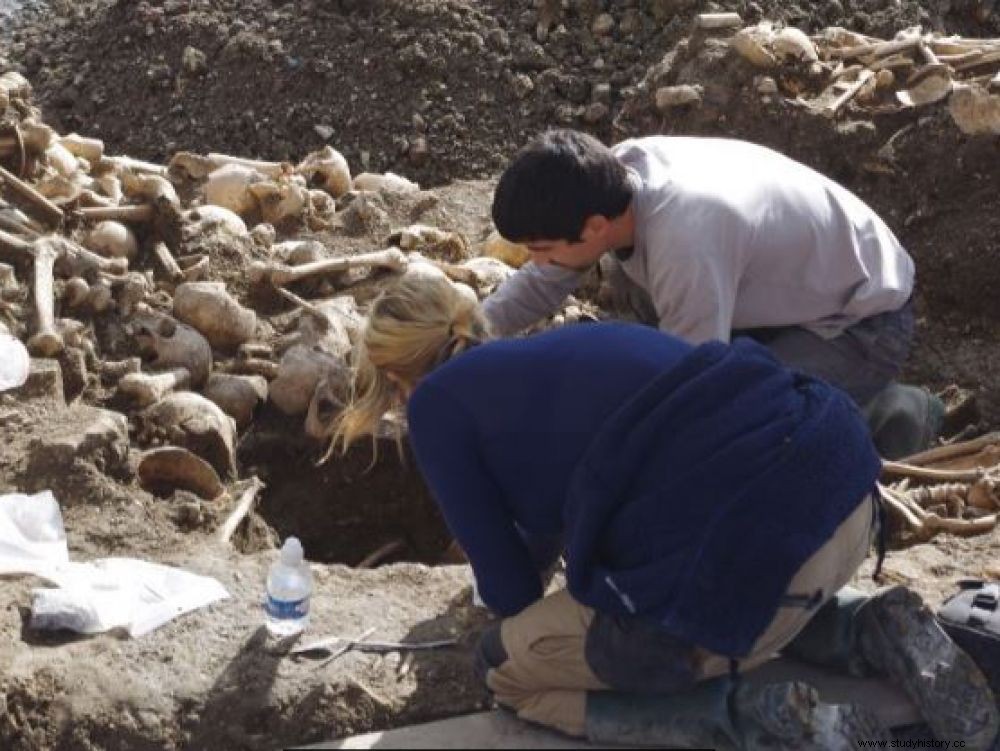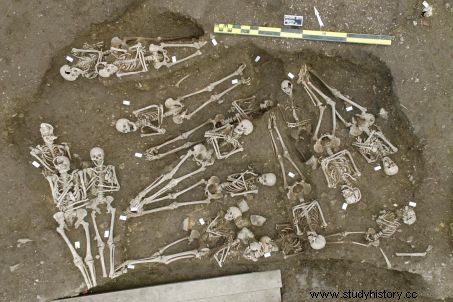Historic graves containing hundreds of bodies have been discovered in Amiens, in the Somme, during a preventive archeology operation.

Graves of plague victims discovered on the former site of the Hôtel-Dieu in Amiens, during preventive archaeological excavations.
“We did not expect to encounter such quantities of remains !” says Yves Lebechennec. Especially on the site of an old garage. The member of the archaeological service of Amiens-Métropole (Somme) has just unearthed with his colleagues exceptional pits as part of preventive excavations of a plot of the city. Multiple mass graves have been cleared from the surroundings of a medieval building, destroyed in 1940 during German bombardments, located in the gardens of the former Hôtel-Dieu, on the banks of the river. All scattered over the 1500 m2 of the site. “These are crisis graves. They were dug in an emergency during a major epidemic episode which led to high mortality. Probably an outbreak of plague “, explains Elodie Jadelot, archaeoanthropologist. “We knew that this sector housed a cemetery used between the 13 th and the 17 th century, but our surprise was to find all these pits on the outskirts “, continues Richard Jonvelle, in charge of the operation. "With the cemetery and the graves, we are already at more than a hundred individuals, and we are sure that we will find many more “, predicts Yves Lebechennec. Stacked on several levels, the bodies were buried in the ground in shrouds closed with pins, as indicated by the large quantity of staples collected.
Active as early as 1230, the Hôtel-Dieu was a "hospital" for the indigent run by clerics that operated until the 17th century. century. How did it suddenly find itself hosting such diverse populations? Information from the historical archives of the city of Amiens gives a small idea. It is noted that in 1632, "the municipality asked the Hôtel-Dieu to take charge of all the plague-stricken Obviously with the aim of creating a sanitary cordon and taking isolation measures, specifies Elodie Jadelot. "This is how in these pits we find all age groups and social categories, as is often the case with the plague “, continues the anthropologist.

Aligning the bodies in the plague pits. © SSAM Amiens-Metropolis
As crisis burials are very rare, researchers see the case of Amiens as a godsend. "We will be able to compare the populations present in the graves - where all the inhabitants of Amiens, including the most well-to-do, were carried away by this devastating disease - with those more "classic" in the cemetery, destitute with their traces nutritional deficiency “, specifies Elodie Jadelot. “The other interest of this project was to discover that there was a large organization for the management of mass deaths. Unfortunately, proof of a certain adaptation to a situation that should have lasted for some time. The bodies were well aligned, without being thrown anyhow “, adds Yves Lebechennec. Historical elements concerning Amiens found in a publication by Charles Schmidt, published in the review of modern and contemporary history (1900) confirm these statements. "In 1633, the plague ravaged the city, the inhabitants died en masse, misery and famine were added to the disease", specifies the document which certifies that more than 300 patients were in the Hôtel-Dieu and that each night six or seven additional families were affected. It is also specified that "three years of plague had ruined Picardy".
In addition to these pits, the remains of a 40 m long building began to rise from the ground. Started in August 2017, this work, which aimed to study the relationship between the city and its river, should be completed by the end of the year.
*note:These elements come from:"The role and attributions of a "Finance Intendant" to the Sublet armies of Noyers from 1632 to 1636 ", by Charles Schmidt. Published in the journal of modern and contemporary history. Year 1900, vol2., n°2, pp. 156-175
